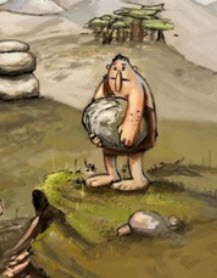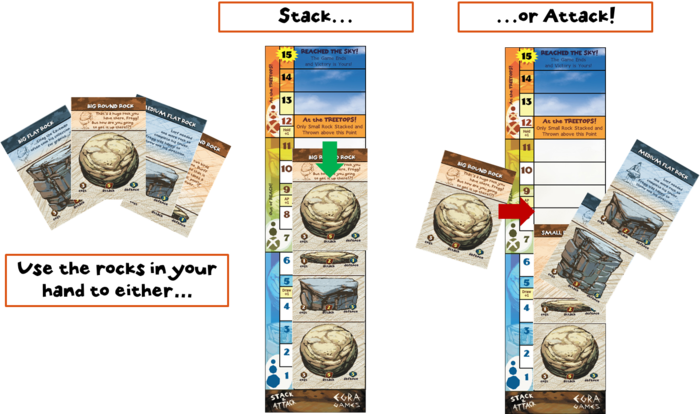
Hello. Me Nrg.
It not good time to be Nrg. Nrg want food, but food not around.
All Nrg has is rocks. Nrg cannot eat rocks.
Nrg friend Rrak eat rocks for food. Rrak now dead. Nrg took Rrak’s rocks. But still no food.
Nrg people say we stack rocks, honor earth spirit for bountiful rocks it give. Get more attention for Nrg’s people. Then earth spirit give more food.
Nrg try. Nrg smarter than Rrak. Stupid Rrak.
This little story from our caveman friend is the game of Stack & Attack in a nutshell. In the most primitive deckbuilder around, players represent various clans of cavemen competing with one another for the attention of their new found deities. The only resources they have in abundance (and within their skillset) are stones, and so they now believe is that creating the tallest rock pillars will gain their gods’ blessings.
Stack & Attack is designed as a family-friendly deckbuilder with a very simple premise. Each player receives a starting hand of ten cards. These cards come in two different types (Round and Flat) and three sizes (Small, Medium, and Large). Each player also gets their tower stack placard. The tower ranges in number from 1-15, denoting the height of the player’s tower. Each sized rock takes up one height amount. A Large rock, for example, has a height of three. In the middle of the players is the card purchase pool, where players will be able to purchase additional rocks, as well as some cards that do various abilities.
Players have a hand of three cards, and each turn they have 4 Action Points to spend, which can be spent to do do any combination of the three actions: Stacking Rocks, Purchasing Cards, or Throwing Rocks. All Rocks contain the AP amount to do anything with it, as well as an Attack and Defense value. If a player stacks a rock, they put the card onto their placard, and taller stacks provide additional bonuses such an extra AP or an additional card in their hand. Conversely, if a player purchases a card, it goes into their discard pile. At the end of the turn, the player discards their hand, and, unlike most deckbuilders, immediately shuffles their discard pile into the deck and draws a new hand.
The appeal to Stack & Attack clearly comes from the ‘Attack’ side of it all. You don’t want to let an opponent’s tower get taller than yours, so players will be lobbing attacks at a specific rock in each other’s tower. When this happens, both the attacking and defending player reveal two cards from the top of their deck. The attack value will be the total value of the rock thrown plus the values on the two attacker’s revealed cards. The defense value is the value of the rock targeted, plus the defense of all rocks stacked above it, plus the defense values of the two cards the defender revealed.
If the attack is successful, both cards are destroyed and removed from play. Any rocks stacked above it fall over into their discard pile. If unsuccessful, the defender puts the thrown rock into their discard pile. Because, you know, you threw it. It’s theirs now. Either way, any of the modifier cards used are discarded and that attack is concluded.
Players continue to wreak havoc on one another until the a player reaches a height of 15 rocks. They have gained all the glory that a pile of rocks can bestow and are the winner.
Suffice it to say, Stack & Attack doesn’t reinvent the wheel here. In fact, it doesn’t even invent the wheel. There are no wheels here. Stop focusing on wheels.
Instead, Stack & Attack successfully modifies a more advanced game mechanic – that of deckbuilding – and makes it accessible for a wide audience. It has a very basic premise, the rules are largely intuitive, and for a deckbuilder, it’s incredibly quick. Like everyone starts out with Gold in Dominion quick. Sessions of Stack & Attack is playable in under 30 minutes, even with multiple people.
Moreover, it also keeps the game moving quickly by use of its culling mechanic: throwing rocks. Players can pitch rocks they no longer feel they have use for at another player simply to get it out of their deck. (And hey, if it takes some other rocks with it, so be it.) This creates a deckbuilder that focuses less on creating combos or play engines, and instead ensures the game is a basic, streamlined affair.
Stack & Attack proves to be an interesting little surprise, especially for those who may dismiss the game because its theme is about piling up and throwing rocks. It’s more engaging than it first appears, but it never crosses the line into unnecessarily complicating things. It accepts its role as a short, light game that’s inviting to a variety of players. It’s about as simple a deckbuilder as you can get while still feeling that there are strategic options to be made (and there are). It’s a silly, light-hearted game about our ancient ancestors, and it’s an ideal option for a family game, as kids should throughoutlly enjoy being told that they not only get to throw rocks inside, but that they’re being encouraged to do so. If you you want to build up some shrines and bring some favoritism to your tribe, feel free to converse with the other cavemen down at their Kickstarter.

